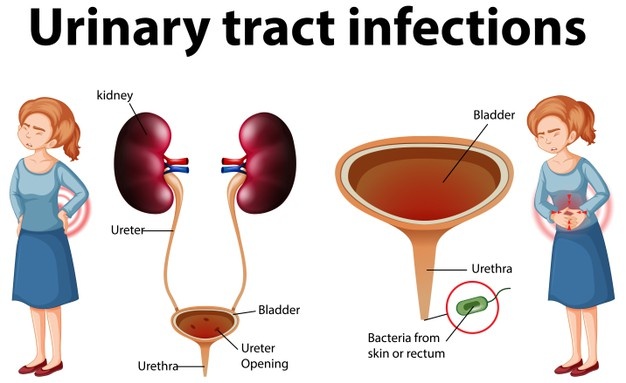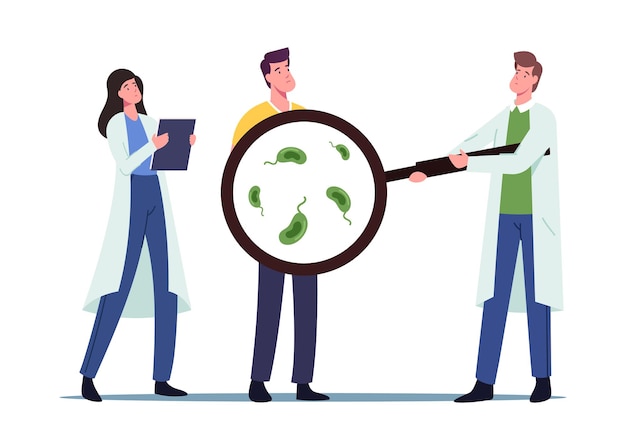Infections affecting the bladder, urethra, uterus, ureters, or kidneys, called urinary tract infections (UTIs), are quite common. UTIs can be viral or fungal but are primarily bacterial in nature. Due to their anatomy, women have a higher risk of developing UTIs than men and children. All who suspect they have a urinary tract infection probably wonder how long a UTI lasts. To provide information on the duration of the infection, we will discuss some of the general symptoms of UTI and the Treatment and Duration of UTI available in this discussion.
What is a Urinary Tract Infection (UTI)?

A urinary tract infection (UTI) is an infection of the urinary system. This type of infection can affect the urethra (a condition called urethritis), the kidneys (a condition called pyelonephritis), or the bladder (a condition called cystitis).
Your urine usually does not contain bacteria (germs). Urine is a by-product of our filtration system: the kidneys. When waste products and excess water are removed from the blood by the kidneys, urine is created. Normally, urine flows through the urinary system without any contamination. However, bacteria can enter the urinary system from outside the body, causing problems such as infections and inflammation. This is a urinary tract infection (UTI).
Two Categories:
Urinary tract infections generally fall into two categories:
1. Lower Urinary Tract Infections:
Lower urinary tract infections are concentrated in the urethra and bladder, known as the lower urinary tract. If it’s in the bladder, the UTI is called (surprise!) A bladder infection or cystitis. Lower UTIs make up the vast majority of urinary tract infections and are easily treatable with antibiotics.
2. Upper Urinary Tract Infections:
These urinary tract infections are rarer and more serious. Upper UTI usually occurs when an untreated lower UTI has spread to the kidneys. Kidney infection (pyelonephritis) requires medical intervention to prevent permanent damage.
What is The Urinary Tract?
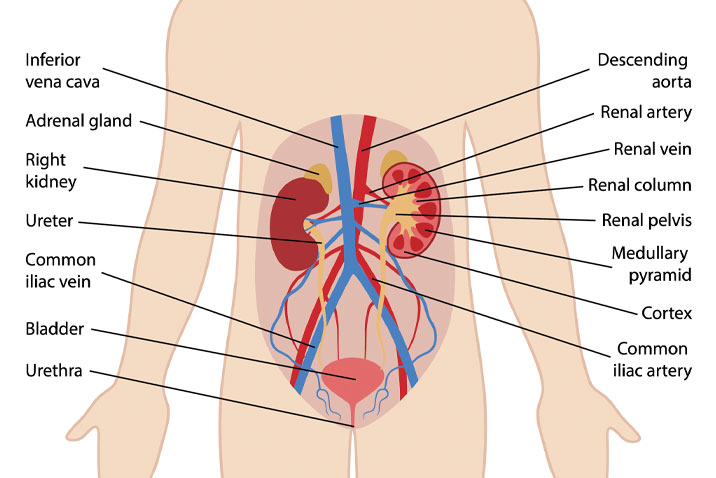
The urinary tract produces and stores urine, one of the body’s liquid wastes. The urinary tract consists of the following parts:
Kidneys

These small organs are found at the back of the body, just above the hips. They are your body’s filters that remove waste and extra water from your blood. This waste becomes urine.
Ureters
The ureters are thin tubes that carry urine from the kidneys to the bladder.
Bladder
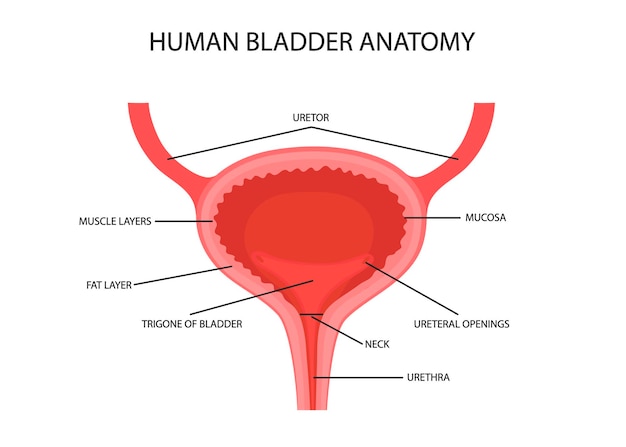
In a pocket-like container, the bladder stores urine before it leaves the body.
Urethra
This tube carries urine from the bladder to the outside of the body.
What is the Difference Between (UTI) and Bladder Infection (Cystitis)?
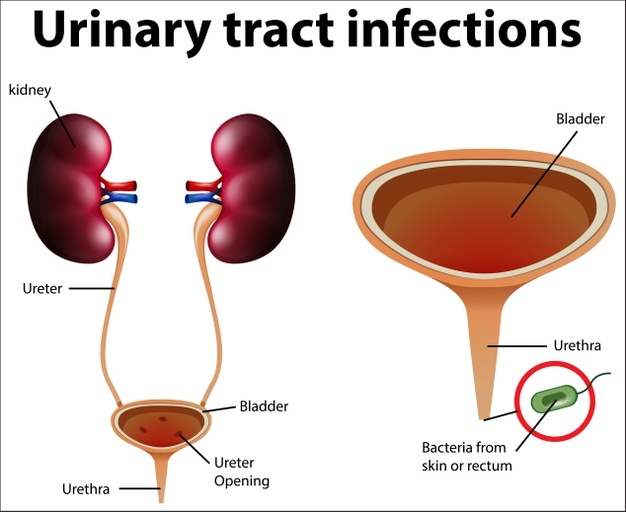
The difference between a UTI and a bladder infection is that a urinary tract infection is a more general type of infection. There are many parts of the urinary tract. The urinary tract is a term for an infection that occurs throughout the urinary tract. A bladder infection, also called cystitis, is a specific infection. In this infection, bacteria enter the bladder and cause inflammation.
Not all urinary tract infections become bladder infections. Preventing the spread of infection is one of the most important reasons to treat a urinary tract infection early when you have symptoms. The infection can spread not only to the bladder but also to the kidneys, which is a more complicated type of infection than a urinary tract infection.
Kidney pain is felt on the sides or in the back. It is often mistaken for back pain. Kidney pain can be caused by urinary tract infections, kidney stones, kidney infections, injury, or kidney cancer.
The Difference Between Back Pain and Kidney Pain

Kidney pain is easily confused with just ordinary back pain. How do you know the difference between Back pain and Kidney pain?
Kidney pain is discomfort that comes from the area where the kidneys are located. It is often described as a dull ache, felt in the sides, back or stomach. But the pain in these areas isn’t always a sign of a kidney problem. It’s easy to confuse kidney pain with normal back pain.
Area
It could be your kidney and not your back if you can feel it higher up on your back. The kidney pain is higher and deeper in your body than the back pain. You can feel it in the upper half of your back, not the lower half. Unlike back discomfort, it is felt on one or both sides and usually under the rib cage. It is often constant. It probably won’t go away when you move your body. Along with your back, it may decrease as you adjust the position.
What are the Symptoms of a Urinary Tract Infection (UTI)?
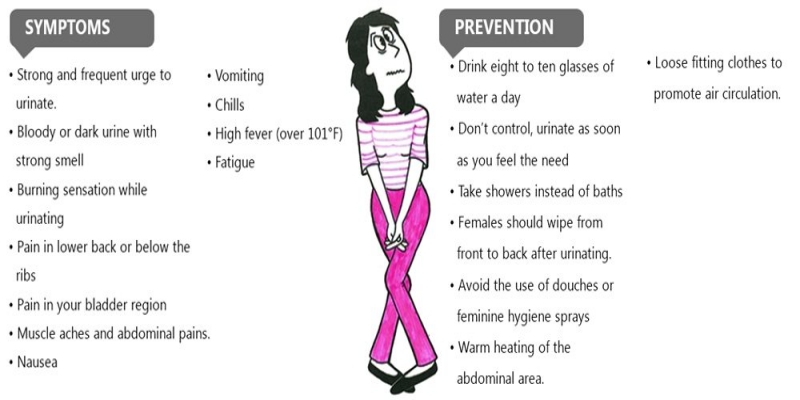
A urinary tract infection causes redness and irritation of the lining of the urinary tract (inflammation), which can produce some of the following symptoms:
The Symptoms of a UTI Include:
- Need to urinate at night
- Pressure in the lower pelvis
- Painful urination (dysuria) and blood in the urine
- Pain in the left or backside (flank), abdomen, or pelvic area
- Abnormal color of urine (cloudy urine) and strong or foul-smelling urine
- Frequent need to urinate (frequency), urgent need to urinate (urgency), and incontinence (loss of urine).
Other Symptoms of Kidney Pain that may be associated with a Urinary Tract Infection Include:
- Vomits
- Tiredness or fatigue.
- Pain during sex.
- Pain in the penis.
- Mental changes or confusion.
- Pain in the flank (side of the body) or low back pain.
- Fever (temperature over 100 degrees Fahrenheit) and chills.
If you have any of these symptoms get yourself diagnosed.
Diagnose Your UTI, Go To The Doctor
Do you think you have a UTI? The good idea is to find OTC UTI test strips that you can perform in the comfort of your home. These UTI tests will give you quick results and help your doctor make a faster decision about whether or not you need antibiotics to treat your UTI if you do.
If you don’t have over-the-counter UTI test strips, go straight to your doctor! Your doctor may say to have a complete pelvic examination to check for other infections, as symptoms of UTIs and sexually transmitted infections are sometimes similar. In any case, you know prevention is better than cure! Be sure to use the test kit at home before taking urinary pain relievers to avoid inaccurate results.
Risk Factors:
Understanding the causes of urinary tract infection can help you prevent them before it happens. Here are some risk factors:
Age:
There is evidence suggesting that postmenopausal women are at an increased risk of recurrent UTIs due to urinary incontinence and estrogen deficiency that naturally occur after the transition to menopause.
Genetics:
Remember how we said that some women get urinary tract infections much more often than others? Often it’s not their fault, and it depends on the genes. If someone in your family regularly has a urinary tract infection, you may be at increased risk for urinary tract infections.
Biological Sex:
Women have urinary tract infections up to 30 times more often than men. This is mainly due to the anatomy. We all know that a woman’s urethra is shorter than a man’s, making it easier for bacteria from her anus to enter the urinary tract.
Frequent Activity of Sex:
UTIs are often caused by bacteria that migrate from the rectal area into the urinary tract and then settle in the urethra. Sex is a risk factor because the friction that occurs in the genital area during sexual intercourse can promote this migration. Masturbation can too. Fortunately, peeing after sexual activity can help prevent urinary tract infections. The urine stream helps clear the urinary tract and flush out unwanted bacteria before it becomes a problem.
Your Contraception:
Most contraceptives have nothing to do with urinary tract infections, with one notable exception: spermicide. This can kill some of the good bacteria in the genital area, making it harder for your body to fight the unwanted bacteria that cause UTIs.
Personal Hygiene:
Daily habits like scrubbing from back to front, leaving sweaty clothes for hours, or forgetting to change your underwear or wash sex toys can increase your risk of UTIs.
Home Remedies for UTI
A quick internet search yields many articles that swear that some home remedies like cranberry juice cure UTI. Most of these treatments are safe to try in moderation, but they should not replace seeking professional advice.
For example, some scientific evidence suggests that an active ingredient in cranberries called proanthocyanidins can prevent bacterias like E. coli from adhering to the urinary tract, making it less likely for bacteria to cling and cause infection. Certain probiotics and vitamin C supplements can also help prevent urinary tract infections, and probiotics have the added benefit of reducing diarrhea caused by taking antibiotics. However, more research is needed to show that these alternative treatments are effective.
If you choose to try a home remedy, remember that untreated UTIs can worsen over time and develop into kidney infections, leading to emergency hospitalization in severe cases. A urinary tract infection is not something you want to delay or avoid talking to your doctor about – call it at the first sign of symptoms.
Potential Complications of UTI
You don’t want to leave a UTI untreated. The bacteria can spread to the upper respiratory tract, leading to kidney infection. It is no joke and requires a more aggressive treatment plan to prevent kidney scarring or organ failure. So make an appointment with your doctor.
Treatment and duration of UTI
Your health care clinic professional will first perform tests to identify the type of UTI the patient is believed to have. This usually involves taking urine samples to look for bacteria, red blood cells, white blood cells, and to test for chemicals in the urine (like nitrates). In other cases, blood tests, CT scans, kidney scans, or ultrasounds may be ordered to diagnose the infection. For mild lower urinary tract infections (bladder infection), most patients will be prescribed an antibiotic supplement to prevent UTIs from spreading to their kidneys.
How long does a UTI last?

For most cases of uncomplicated urinary tract infections (UTIs), you will need to take a 3-day course of antibiotics and make sure you stay hydrated; some infections, however, may require longer treatment for up to 7-10 days of antibiotics can last up to 2 weeks or more. How long does a UTI last? Recovery time depends upon the following:
- Your medical history.
- What type of medicine is used?
- What type of bacteria is causing the infection?
Symptoms such as pain and the need to urinate can often go away quite quickly after you start antibiotics. But it’s important to take the full course of antibiotics to make sure the infection is gone completely, as it can stay in your body for some time.
How Long Does it Take for a Urinary Tract Infection to go Away Without Antibiotics?
Some urinary tract infections go away without antibiotic treatment. In fact, several studies have shown that 25 to 50% of UTIs can go away on their own within a week.
However, you will want to ask yourself if this is the right path for you. If you do not continue treatment and your UTI does not resolve on its own, you could end up with a more serious infection and a longer recovery time. If your UTI is extremely bothersome and won’t go away, your doctor will likely want to see you for an exam and urine culture to look for specific bacteria causing the infection and choose a different treatment.
Is The UTI Treatment Completed? Get The Green Route from Your Doctor
Great, you’ve been taking antibiotics regularly as prescribed, and you’re finally done treating UTIs; now what? Go back to the doctor’s office! You’ll need to take another pee test to make sure you’ve officially gotten rid of this horrible UTI. Never assume that your urinary tract infection has magically disappeared on its own, as bacteria are “sticky” and cannot be easily cleared out from the urinary tract.
Better yet, go to the store for a supplement; they help flush out the urinary tract! Make sure to get proper treatment for a urinary tract infection from your doctor, and once you know the urinary tract infection is gone, take a supplement to help maintain a healthy urinary tract.
Frequently Asked Questions FAQs:
1. Why do we feel Lingering Pain after Passing a Kidney Stone?

Lingering pain after passing a kidney stone may be a sign that you have another stone, blockage, or infection. It could also be an unrelated problem. Kidney stones can also cause nausea, vomiting, or blood in the urine. Fever can be a sign of infection and should be considered a medical emergency.
2. Is Cramping a Sign of Kidney Infection?

Many of us often feel cramps during periods. Do some people tend to wonder if cramping is a sign of kidney infection? To answer this simply, Cramping is a common symptom of a kidney and urinary tract infection. You will usually feel them in the pelvic area or in the lower back. In addition to cramping, you may also feel pressure or pain in this area.
3. Can UTIs go Away on Their Own?
Occasionally! If the urinary tract infection is minor and uncomplicated, your body may be able to fight off the infection without medication. However, most doctors recommend a course of antibiotics because it is a sure-fire way to rid the body of the infection and make sure it does not get worse.
4. How Long Does a UTI Last?

In normal cases, while getting antibiotics supplement treatment, it usually lasts for 3-10 days. But in severe cases, it can last from 10 to 20 days.
5. When to See a Doctor?

If symptoms consistent with a urinary tract infection appear – painful urination, abdominal discomfort, frequent urination, or blood in the urine – see a doctor. Your doctor is a resource to help you understand the type of UTI you have, its severity, and the best course of action for treatment. The good news is that your discomfort may end in a few days if you take action now to deal with it.
6. How Long Does an Untreated Urinary Tract Infection Last?
Some UTIs go away on their own within a week. However, UTIs that don’t go away on their own will only get worse over time. If you think you have a UTI, talk to a doctor about the best course of action.
